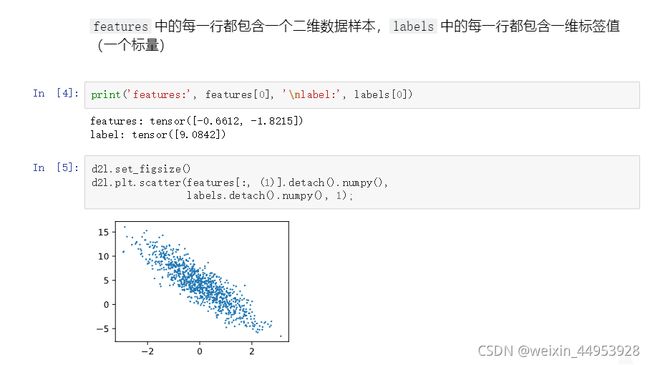动手深度学习:08 线性回归(线性回归的从零开始实现)(二)
1、线性回归的从零开始实现
我们将从零开始实现整个方法,包括数据流水线、模型、损失函数和小批量随机梯度下降优化器
d2l包可以直接在conda的prompt里面输入命令 pip install -U d2l 来安装
%matplotlib inline
import random #导入随机数包
import torch #
from d2l import torch as d2l #l是字母
def synthetic_data(w,b,num_examples):
"""生成y=Xw +b+ 噪声"""
X=torch.normal(0,1,(num_examples,len(w)))
y=torch.matmul(X,w)+b
y+=torch.normal(0,0.01,y.shape)
return X,y.reshape((-1,1))
true_w =torch.tensor([2,-3.4])
true_b=4.2
features,label=synthetic_data(true_w,true_b,1000)
features中的每一行都包含一个二维数据样本,labels 中的每行都包含一维标签值(一个标量)
print('features:',features[0],'\nlabel:',labels[0])
定义一个data_iter 函数, 该函数接收批量大小、特征矩阵和标签向量作为输入,生成大小为batch_size的小批量
def data_iter(batch_size, features, labels):
num_examples = len(features)
indices = list(range(num_examples)) #0到1000
# 这些样本是随机读取的,没有特定顺序
random.shuffle(indices)
for i in range(0, num_examples, batch_size):
batch_indices = torch.tensor(indices[i:min(i +
batch_size, num_examples)])
yield features[batch_indices], labels[batch_indices]
batch_size = 10 #小批量
for X, y in data_iter(batch_size, features, labels):
print(X, '\n', y)
break
tensor([[ 0.0527, -0.2697],
[-0.9873, 0.3681],
[ 1.2239, -0.6601],
[ 1.1599, -0.6122],
[-1.9831, 0.5967],
[ 0.0946, 0.6731],
[-2.4599, -0.7290],
[-0.9440, 0.8467],
[ 0.6230, -0.6486],
[-0.5504, 0.4925]])
tensor([[ 5.2405],
[ 0.9606],
[ 8.8817],
[ 8.5919],
[-1.7813],
[ 2.1116],
[ 1.7657],
[-0.5781],
[ 7.6454],
[ 1.4349]])
定义 初始化模型参数
我们通过从均值为0、标准差为0.01的正态分布中采样随机数来初始化权重,并将偏置初始化为0。
w = torch.normal(0, 0.01, size=(2, 1), requires_grad=True)
b = torch.zeros(1, requires_grad=True)
定义模型
def linreg(X, w, b):
"""线性回归模型。"""
return torch.matmul(X, w) + b
定义损失函数
def squared_loss(y_hat, y): #预测值,真实值
"""均方损失。"""
return (y_hat - y.reshape(y_hat.shape))**2 / 2
定义优化算法
def sgd(params, lr, batch_size): #params:是一个list
"""小批量随机梯度下降。"""
with torch.no_grad():
for param in params:
param -= lr * param.grad / batch_size #param.grad梯度,batch_size学习率
param.grad.zero_()#把梯度设置为0
训练过程
lr = 0.03 #学习率
num_epochs = 3 #数据扫三遍
net = linreg #线性回归模型
loss = squared_loss #均方损失。
for epoch in range(num_epochs):
for X, y in data_iter(batch_size, features, labels): #batch_size 小批量
l = loss(net(X, w, b), y) # x和y的小批量损失
#因为l的形状是[batch_size,1],而不是一个标量,l中的所有元素被加到
#并以此计算关于[w,b]的梯度
l.sum().backward()
sgd([w, b], lr, batch_size)
with torch.no_grad():
train_l = loss(net(features, w, b), labels)
print(f'epoch {epoch + 1}, loss {float(train_l.mean()):f}')
epoch 1, loss 0.033103
epoch 2, loss 0.000124
epoch 3, loss 0.000054
比较真实参数和通过训练学到的参数来评估训练的成功程度
print(f'w的估计误差: {true_w - w.reshape(true_w.shape)}')
print(f'b的估计误差: {true_b - b}')
#输出
w的估计误差: tensor([ 0.0006, -0.0004], grad_fn=)
b的估计误差: tensor([0.0003], grad_fn=)
#2. 线性回归的简洁实现
通过使用深度学习框架来简洁地实现 线性回归模型 生成数据集
import numpy as np
import torch
from torch.utils import data
from d2l import torch as d2l
true_w = torch.tensor([2, -3.4])
true_b = 4.2
features, labels = d2l.synthetic_data(true_w, true_b, 1000)
def synthetic_data(w,b,num_examples):
"""生成y=Xw +b+ 噪声"""
X=torch.normal(0,1,(num_examples,len(w)))
y=torch.matmul(X,w)+b
y+=torch.normal(0,0.01,y.shape)
return X,y.reshape((-1,1))
true_w =torch.tensor([2,-3.4])
true_b=4.2
features,label=synthetic_data(true_w,true_b,1000)
调用框架中现有的API来读取数据
def load_array(data_arrays, batch_size, is_train=True):
"""构造一个PyTorch数据迭代器。"""
dataset = data.TensorDataset(*data_arrays)
return data.DataLoader(dataset, batch_size, shuffle=is_train)
batch_size = 10
data_iter = load_array((features, labels), batch_size)
next(iter(data_iter))
[tensor([[-0.3503, -1.4372],
[-1.0654, 0.4921],
[ 0.3208, 0.4166],
[-2.5884, -0.9802],
[-1.6644, -0.0677],
[ 0.7457, 1.1798],
[-1.4640, 1.7983],
[ 0.0327, -1.6439],
[-0.8879, -1.6287],
[-0.8156, -1.5579]]),
tensor([[ 8.3842],
[ 0.3884],
[ 3.4247],
[ 2.3456],
[ 1.0868],
[ 1.6896],
[-4.8205],
[ 9.8460],
[ 7.9508],
使用框架的预定义好的层
#nn是神经网络的缩写
from torch import nn
net = nn.Sequential(nn.Linear(2, 1))
初始化模型参数
net[0].weight.data.normal_(0, 0.01) #权重
net[0].bias.data.fill_(0) #偏差
tensor([0.])
计算均方误差使用的是MSELoss类,也称为平方 范数
loss = nn.MSELoss()
实例化 SGD 实例
trainer = torch.optim.SGD(net.parameters(), lr=0.03)
训练过程代码与我们从零开始实现时所做的非常相似
num_epochs = 3
for epoch in range(num_epochs):
for X, y in data_iter:
l = loss(net(X), y)
trainer.zero_grad() #先把梯度清零
l.backward() #这里pytorch已经做了sum
trainer.step() #调用
l = loss(net(features), labels)
print(f'epoch {epoch + 1}, loss {l:f}')
epoch 1, loss 0.000232
epoch 2, loss 0.000101
epoch 3, loss 0.000102
比较生成数据集的真实参数和通过有限数据训练获得的模型参数
w = net[0].weight.data
print('w的估计误差:', true_w - w.reshape(true_w.shape))
b = net[0].bias.data
print('b的估计误差:', true_b - b)
w的估计误差: tensor([1.3828e-05, 9.5677e-04])
b的估计误差: tensor([0.0005])

